Let's come up with the fastest graphics card
for single processors with startling efficiency. But it is not its performance
that blows you.
The Nvidia GeForce GTX 680, based on the
design of Kepler released a year ago, is a product…, although the latest
products have recently developed more and more slowly. Many of us expect AMD
and Nvidia to make new processors and technologies in the spring of 2013 but
that did not happen. Moreover, the traditional announcement in the autumn has
nothing to be relied on based on the recent news. For example, AMD has decided
to change the names of their graphics cards again.
There is still at least a very attractive
product that is completely new. That is the Nvidia GeForce GTX Titan.

Nvidia
GeForce GTX Titan
Produced as a limited edition (only 10,000
units) with a suggested price of $999 for each, this is not a mass-produced
product. The GK110 processor installed on Titan is of the Tesla K20X
professional card, designed for supercomputers and high-capacity servers.
There, we have different standards, which is why the computer user, in his
perspective, explains for a very high price for a single-GPU graphics card.
Let's take a look what Nvidia brings with
such a big amount of money.
Design improvements
The GK110 chip based on Kepler‘s design is
produced based on the 28nm technology process and contains 7.1 million
resistors. Featured with 2688 CUDA cores, it has the theoretical SP computing
power of 4.5 teraflops.
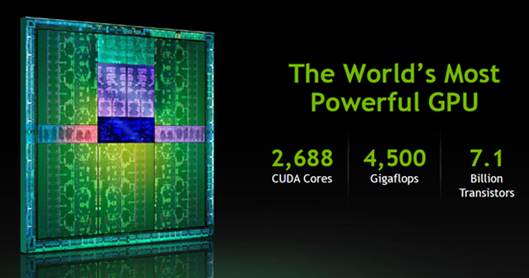
The
GK110 chip
Here is an interesting comparison between
the top Nvidia with Intel’s leading CPU
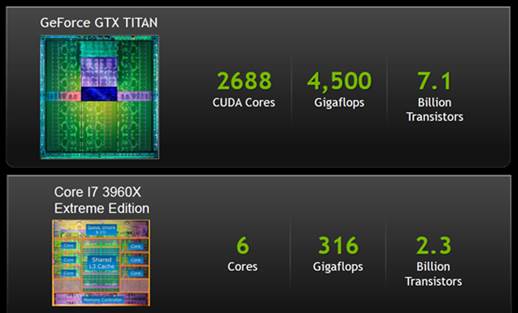
The
GeForce GTX Titan with Intel Core I7
The GK110 has 15 SMX units, but only 14 of
them are active. There are 224 groups of texture maps and 48 image raster in
this graphics cards.
Opposed to the GK104, for example, used in
the GeForce GTX 680, the GK110 has 64 units (FP64) which gives double the precision
with the highest theoretical performance of 1.3 teraflops. So, the GK110 with
896 operational cores supports double the precision of calculations.
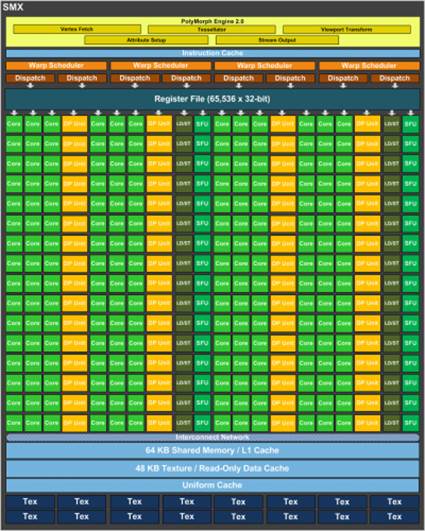
The
structure of the GK 110
Next, the GeForce GTX Titan features
384-bit memory bus while the leading GeForce GTX 680 previously had 256-bit.
The number of onboard memories of up to 6 gigabytes is an impressive numbers.
This allows the new graphics card to work comfortably in extremely high
resolution.
Besides the improvement in the structural
design, the GeForce GTX Titan supports the second version of the GPU Boost
dynamic overclocking technology:

GPU
Boost 2.0 Technology
The GPU clock speed was formerly dependent
on voltage/power.

The
GPU clock speed in the previous products
…but the GPU Boost 2.0 added the
temperature limit for GPU overclocking process.
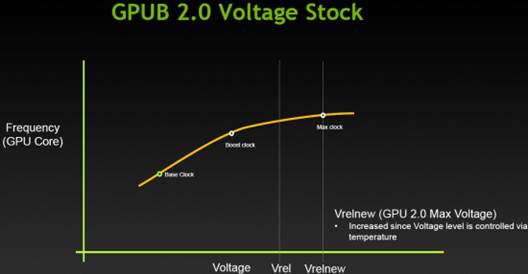
The GPU
clock speed with GPU Boost 2.0
The limitation here is 800C for
the GK110 in default mode, but you can increase it up to 940C to
allow for graphics cards to be able to operate with higher clock speeds.

The
GPUB 2.0 Voltage Overvoltage
In other words, the GPU Boost 2.0 can
increase the performance of the GeForce GTX Titan as it can; on the other hand,
it ensures the automatic control of the cooling process, keeping the GPU
temperature always within the safety limits.

Increasing
performance with GPU Boost 2.0
So far, we can tell you that the
temperature is the main factor for the successful overclocking of the GK110
chip.

The
GPU Boost 2.0Efficiency
At the time of this article, the Titan has
been fully supported by EVGA Precision X utility version 4.0.0:

The
EVGA Precision X version 4.0.0
This utility can be used to overclock the
Titan by controlling the power parameters such as temperature and voltage
increases.
And now we consider how this graphics card
looks like.
PCB Design and function
The new GeForce GTX Titan looks like the
GeForce GTX 690 if observed with the naked eyes. It is the color of the front
surface of the same metal, the similar printed forms and polycarbonate window:

The
product image
There is a logo with the LED highlighting
the product:

The
logo with LED light
The GeForce GTX Titan is 267 mm long,
exactly like the normal size of the modern graphics cards.
It's not much different from the GTX 680,
considering its video interface: DVI-I and DVI-D (dual link), 1 HDMI version
1.4a and DisplayPort 1.2.

The
connectors
On the opposite side near the end, we can
see an exposed part of the heatsink and a pair of screws to keep the safety of cooling
covers.
The Titan has two GeForce GTX MIO connectors
to create multiple configurations with multiple GPUs, not just two, but three
or even 4 graphics cards like that.
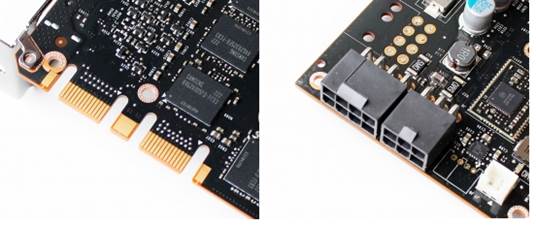
The
MIO connector
Having the 8- and 6-pin power adapter ports
on the printed circuit board PCB, the card looks just like the GTX 690
(2x8-pin) and the GTX 680 (2x6-pin) at the request of its power. Based on the
specifications, the Titan is believed to consume less than 250 watts. A
600-watt PSU or higher is recommended for a computer with such devices.
The Titan's circuit board featuring the
original design with the memory chips is placed on both sides of it:

The
Titan’s printed circuit board
Contrary to our expectations and with the 384-bit
memory bus, the GPU has a 6-phase power system with the components of Dr. MOS,
almost identical to the original GeForce GTX 680.
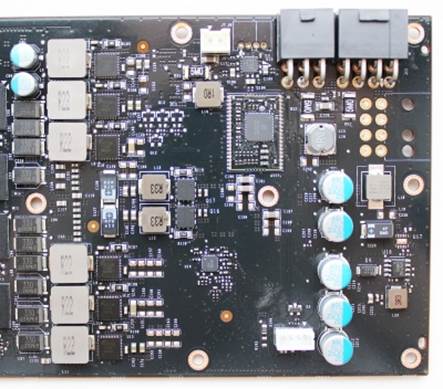
The
onboard power system
They are managed by the ON Semiconductor
NCP4206 control device:

The
onboard power system
There are also 2-phase power lines for the memory
of the graphics card and one for the PLL.
The GK 110 GPU area is about 520 mm2
and contains no thermal layer, so we can easily read its version, which is A1,
and the date of manufacture (50th week of 2012).

The
GK110-400-A1
We were talking about the configuration and
specifications of its earlier review. The 3D clock speed is 837 MHz in its
voltage of 1,162 volts and can be enhanced to 867 MHz (something slightly
different than in reality, though, we will explain below right here). The clock
speed and voltage drop to 0.875 volts at 324 MHz and 2D applications.
This graphics card is equipped with GDDR5
chips with FCBGA which gives the total memory capacity of 6 gigabytes. They are
manufactured by Samsung Semiconductor and are marked as K4G20325FD-FC03:

The
K4G20325FD-FC03 chip
The clock speed in 3D mode is 6,008 MHz.
Along with a 384-bit bus, the memory bandwidth is 288.4 GB highest/s, which is
50% higher compared to the GeForce GTX 680 and makes this new graphics card
work faster when in high resolution mode with any full-screen anti-aliasing
does.
The GPU-Z version does not give correctly all
the latest GeForce GTX Titan’s parameters:

Checking
the version with the latest GPU-Z